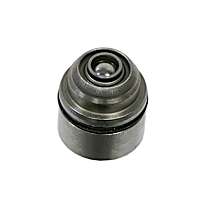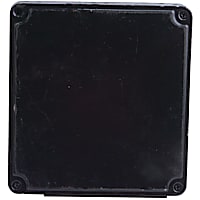One of the OBD-II codes you may come across is the P0020 code. Here is some basic information that may help you understand what this code means.
What Does the P0020 Code Mean?
Diagnostic Trouble Code (DTC) P0020 stands for “Intake “A” Camshaft Position Actuator Circuit / Open (Bank 2).” It is triggered when the powertrain control module (PCM) detects that the voltage from the variable valve timing circuit has fallen out of specification for a calibrated amount of time.
V6 and V8 engines have 2 Banks, and Bank 1 is always the bank where cylinder number 1 is located – the other bank is Bank 2.

Variable valve timing or VVT is a technology used in the engine to achieve greater power and/or efficiency at different running points. The system primarily consists of one or more camshaft position actuators and solenoid valves, also known as oil control valves (OCVs).
The PCM monitors the variable valve timing circuit for high and low voltage. The test fails if the voltage falls out of the manufacturer’s specified range for a calibrated amount of time. When that happens, the PCM sets the code P0020.
If you want an advanced understanding of the camshaft position actuator, the solenoid, and the PCM detection system, you can read our technical discussion, which can help you fix P0020 if you’re planning a DIY solution. Otherwise, continue reading for the most likely causes of P0020.
Note: The definition of the P0020 code may be different depending on the vehicle manufacturer. Consult the appropriate repair manual or repair database for the exact code definition.

What are the Possible Causes of the P0020 Code?
- Variable valve timing actuator failure
- Open or short in the VVT control circuit
- Failed VVT (oil control) solenoid valve
- PCM failure or software in need of an update
What are the Common Symptoms of the P0020 Code?
- Check engine light is on
- Rough running/poor engine performance
- Increased fuel consumption
How to Diagnose the P0020 Code
Identifying the underlying cause of the P0020 code can be difficult, especially if you’re uncertain of your automotive know-how. In most cases, it would be best to bring your vehicle to an auto repair shop and seek the help of a professional for an accurate diagnosis.
Here is a video that can help give you a better idea on how this trouble code might be diagnosed:
How to Fix the P0020 Code
While vehicles from different manufacturers may share common symptoms, there is no universal solution for the P0020 code. The fix may vary depending on its underlying cause and the vehicle’s make and model. For instance, the steps for the diagnosis and repair of a P0020 Ford code may differ from a P0020 Hyundai code’s.
If you’re determined to resolve the P0020 code yourself, research confirmed fixes that are specific to your car’s make and model. Use vehicle repair databases to find the right solution for the code.
More About the Camshaft Actuator, Solenoid, and the PCM Detection System
The camshaft actuator works by sending a “pulse width” signal to the solenoid. That means it turns the solenoid on and off really fast. If you want to learn more about this subject, read our technical discussion about how the camshaft actuator works; otherwise, continue reading for a description of the solenoid and the PCM’s detection strategy.
The solenoid is a simple two-wire unit that typically receives voltage from a relay or is hard-wired to ground. If the voltage is supplied by a relay, the solenoid will be grounded by a PCM output. If the solenoid is hard-wired to ground, voltage will be supplied as a duty cycle by the PCM.

If voltage is supplied to the solenoid and ground comes from the PCM, when the PCM isn’t grounding the solenoid, it expects to see voltage coming all the way through the solenoid winding to the PCM driver – it measures that. When the PCM driver grounds the solenoid, that voltage is pulled to ground and the solenoid operates.
On a solenoid that is hard wired to ground, voltage is duty cycled to the solenoid to open oil passages to the cam phaser so that the camshaft angle target is reached.
On a voltage supplied solenoid where the PCM supplies a ground to cycle the solenoid, if the PCM isn’t energizing the solenoid but doesn’t see the voltage coming through the solenoid when the circuit is at rest, the PCM assumes that circuit is compromised, meaning the solenoid or its wiring is open, or the ground side of the solenoid is shorted to ground somewhere, which will typically store camshaft position codes and cause drivability issues because the solenoid will be on all the time. If the PCM energizes the solenoid and the voltage remains, the PCM knows its internal driver (transistor) for that solenoid has failed.
The PCM’s detection strategy is similar on a solenoid that is hard wired to ground so that the PCM duty cycles voltage to the solenoid. The first schematic shown below is a 2016 Chrysler, where the solenoids are hard wired to ground and voltage duty cycled. It’s a simple circuit. The second schematic is a Ford, where the solenoids are fed by a fuse and ground triggered by the PCM, which is the way Ford typically drives solenoids.
The third schematic is a Toyota, where the PCM controls BOTH sides of the solenoid.



How to Find a New Variable Valve Timing Actuator for Your Vehicle
Once you’ve confirmed that your VVT actuator is faulty, get a replacement right away here at CarParts.com. Why waste time driving between brick-and-mortar shops when you can shop for the parts you need online?
Simply go to CarParts.com, and plug your vehicle’s details into our vehicle selector. Make sure to include the model year and engine to narrow down our catalog and browse compatible parts for your ride.
We source parts and accessories from top brands in the industry, so you can rest assured that you’re only choosing from the best. What’s more, our warehouses are located all over the US, so you can receive your order in a matter of days.
Get back on the road in no time by getting your bad VVT actuator replaced right away. Check out our catalog and order today!
Products Mentioned in this Guide
Any information provided on this Website is for informational purposes only and is not intended to replace consultation with a professional mechanic. The accuracy and timeliness of the information may change from the time of publication.


 Oil Control Valve
Oil Control Valve
 Engine Control Module
Engine Control Module
















